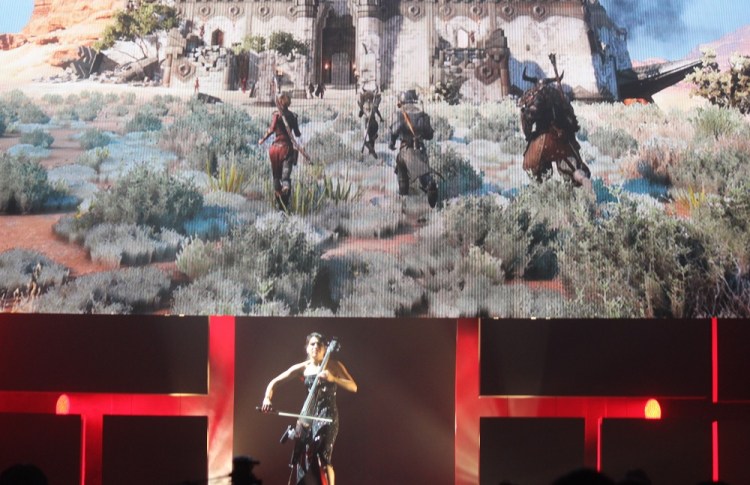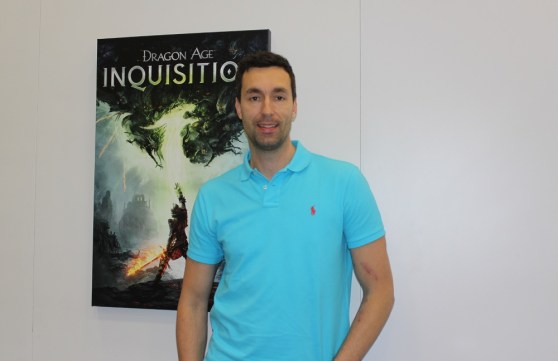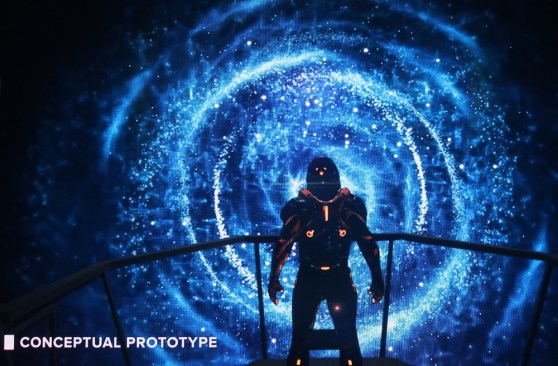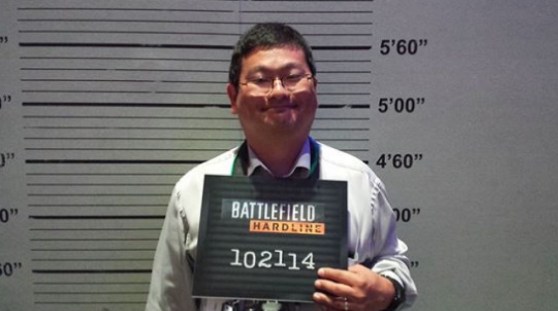Electronic Arts has more brands for video games than it has teams to make games based on those brands. It could dust off an old intellectual property every few years and never miss a beat.
But Patrick Soderlund, executive vice president of EA Studios at the big game publisher, says that EA has to continue investing in new IP or else it will sign its death certificate.
We caught up with Soderlund at the Electronic Entertainment Expo (E3) trade show in Los Angeles last week. At the show, EA showed off new IP from Mass Effect developer BioWare, as well as an air-oriented thrill-seeking game from Criterion. It also moved Battlefield into the cops versus robbers genre, and it signaled that Dragon Age: Inquisition represents a huge investment in time and money. Here’s an edited transcript of our talk.
GamesBeat: I talked to (EA executive) Karl Magnus Troedsson a little bit earlier. He was saying that you guys had a good response to Hardline.
Patrick Soderlund: We did. When you make a creative decision like that, you run a risk. You never know how people might react. It’s a concept that’s been with us for more than 10 years. Probably the first prototype of something like Hardline was at DICE. We did it just after Battlefield 2. There’s still footage that I saw not long ago from that, which looks…not so good.
Newzoon’s Global Games Market Report is now on VB Intel.
The whole idea of a more urban cops-and-robbers type of theme has been there a long time, in multiple iterations that we’ve at least started. Then we’ve always had other ideas and things we’ve had to do. When Karl and Steve Papoutsis told me what they wanted to do, I said, “That’s cool. Go do it.” But you never know if it’s going to work right.
I’m pleased to see a good response. I’m happy that we were able to come here with a solid beta that people can play right away. The response is that it feels polished. It’s a true beta in the sense that we’re here to let people touch it, test the systems, find the problems. We’re also identifying not just bugs, but things we might have thought wrong about, that we can course-correct on and fix based on player feedback. So far, so good.
GamesBeat: Are you already getting requests for main battle tanks, so you can blow up the bank?
Soderlund: Not that I’ve seen. It may come.
GamesBeat: You almost have to retrain the audience in some ways. You’re going to have different stuff in this game.
Soderlund: Battlefield is based on a very simple formula. It’s rock, paper, scissors. 1942 was designed around that. You want an airplane to stand a chance against a tank. You want a tank to stand a chance against soldiers. But you also want to reverse that. Everything should be able to take out everything else with some kind of measure. Your job is to get into position and find that measure. That’s the essence of the Battlefield design.
I think that’s why the Battlefield brand has showed so much elasticity. We’ve been able to go and do 2142, which is a sci-fi game. We’ve been able to go to Vietnam. It’s all felt natural. We’ve also been able to branch out into something like the Bad Company series, which was a very different tone and style. This feels like a natural evolution for us. It shows that the brand can expand. We can do different things with it. I feel good about that.
GamesBeat: That gives you some advantages. This category doesn’t seem as crowded.
Soderlund: There’s a lot of good games coming this fall. We seem to be the only one in this segment, which is a good thing. You have some Battlefield players that are maybe into the Battlefield series mostly for the military fantasy. Some might say, “This may not be for me.” But I think we’ll also see a lot of Battlefield players who like this.
I also think this game can help us attract people who haven’t played Battlefield before, that maybe come from the GTA segment or wherever. They look at this and say, “I’m interested in that.” I’ve met a bunch of people here who have said that. That’s what we hope to get out of it.
GamesBeat: What else are you overseeing right now?
Soderlund: Everything but the Maxis business and mobile. So all the games, all the sports games, Star Wars, everything.
GamesBeat: Does Star Wars count as a reveal? There wasn’t too much there.
Soderlund: I think it was? We showed some stuff. We decided to show a lot of footage earlier than we normally would. We could have gone down the route that some others chose, going to Blur or some other expensive rendering company and making two minutes of spectacular video and slapping a logo on it. People would have clapped. But we chose a different path. We decided to let people in earlier and show them some things that are maybe more unfinished, not so polished, to teach them and invite them into what it means to make a game.
That also comes with a risk of showing things that are not done, showing things that people can’t necessarily touch. Obviously the best thing would have been if we came here with a full game that people could play. We’re not in that phase of production. That was impossible. But we will be there soon.
GamesBeat: I heard a nice compliment about Dragon Age. Someone said that it’s EA’s equivalent of the leveling-up that Bethesda did with Skyrim. Is that some of the ambition behind the game?
Soderlund: That’s the ambition on the team, absolutely. Dragon Age is a game that we’ve allowed to get more time, to be a bit more ambitious with it, to strive for a higher production value, a larger product, a deeper product. I hope that thesis proves to be the right one. If we can be compared to as good a product as Skyrim, such a massive game as Skyrim, then I’m very happy with that.
GamesBeat: You look like you’ve hit your schedules more lately. I don’t know if that’s true or not, but you’re not announcing a game, delaying it, and delaying it again, which is the pattern we’ve seen in some cases.
Soderlund: We’re getting better at hitting our dates, I think. It’s also about when you announce. The original idea was for Dragon Age to come out earlier. We decided to push it. That’s arguably late, then, but I think it was the right thing to do. It’s a balance. You have to have games that you ship on time. But you have to ship them when they’re ready.
It’s the same thing with Hardline. I saw some guys saying, “They should have worked on Battlefield 4 instead.” Well, this is a different team. They’re nothing to do with Battlefield 4. This has been in development for more than two years. This has a longer development time behind it than, arguably, Battlefield 4 and Battlefield 3 had. It’s about how we utilize our resources inside the studio system.
When we know for a fact that we can hit the dates, then we can start communicating them. We’re also getting better at that. That ties back to the whole company being managed in a slightly different way than before. We’re now in a position where we’re trying to create some flexibility. With flexibility, when the company’s doing better, performing better financially, that allows us to be a bit more flexible, and not have to be so tied to hitting a date.
I certainly feel a difference. I get a lot of support from our CFO, Blake, and the rest of the executive team to give the products enough time for them to be as good as possible. We made a very tough decision to prolong the TitanFall project by a couple of weeks. Contrary to what some people may think, that was made solely out of product-based concerns. The game, at that time, was done, but it wasn’t smooth enough. We needed some framerate optimizations. We had a few too many bugs. We needed to clean it up and ship a game that was 100 percent ready.
Did I want us to be able to communicate that earlier? Did I want to be able to avoid that? Absolutely. We found ourselves in a situation where that was impossible. Maybe, in the past, we would have said, “Ship it anyway.” I called up Andrew and said, “We have to let this sit for a couple of weeks.” He said, “If that’s what you have to do for the game, do it.” To me, that was such a good feeling, that we could make a decision based on what’s best for the game and the people who are going to play it. We can do that because we have more flexibility now.
GamesBeat: Next-gen development seems like it’s easier, because it’s all X86-based now. There are still delays happening, but maybe it’s more for quality reasons.
Soderlund: I think that’s true. Most developers out there have been able to master the hardware. That’s not necessarily difficult. It’s a PC-based development platform, in essence, known to many people. It’s absolutely easier to optimize for Xbox One and PS4 than we did in the last generation, especially for PS3.
GamesBeat: I talked to Frank Gibeau a little bit about your prospects on mobile, with Apple doing Metal and so on. There are some interesting technology changes that might help publishers out.
Soderlund: As these phones and tablets get more and more powerful, I think the types of products and games that will appear on them can be different. More higher-fidelity products will appear on these things. That’s where bigger companies, companies known to create higher-fidelity games—Our expertise in game-making becomes more applicable to these machines than it is today. That’s why I’m excited about them. It feels a little bit odd to see something at that fidelity running on an iPhone, but it’s pretty cool.
GamesBeat: Does that make it at all tempting to make your tools available more broadly?
Soderlund: Our philosophy with Frostbite is that it’s an EA-wide engine. It’s now being used by most of the game teams inside EA. If Frostbite Go, as we call it, becomes our de facto mobile technology engine, that’s a good thing. But there are no plans today to license it out to other people.
GamesBeat: How are you feeling about triple-A in general?
Soderlund: It’s an interesting time. We’re seeing the PlayStation 4 and the Xbox One selling really well. The adoption rate is much higher than we’ve seen in the past. We had such a long time between PS3 and Xbox 360 to PS4 and Xbox One that there was a pent-up demand for new hardware. I also think that us human being are getting more and more used to changing and updating our technology more often. We update our phones quite often – every second year? I do it every year if I can. It’s more habitual today for us to update. That’s why I think people wanted something new.
I’m also excited about what online is doing to games, how connected these consoles are. When you buy a game, you start a journey today. Before, you bought a game and played it and that was the end of it. Today you have to come in and decide where you’ll invest your time. Am I going to invest my time in this or that? When you put a disc in your Xbox or PlayStation or download something to the hard drive, that’s when the journey starts. It can go on for 500 hours, depending on the game. The value proposition is far better than it’s ever been.
We’re getting better and better at extending the life of products by providing more and more stuff. I’m super excited about that. I’m excited about Sony talking about free-to-play on the PlayStation. I’m excited about things like Morpheus and Oculus. I can’t think of a better time to be here.
At the same time, it’s also difficult to navigate all these things. It was arguably easier when it was all set. You shipped a game on a DVD and that was the end of it. You could maybe connect and play online, but that’s as far as it went. Today you have FIFA Ultimate Team inside of FIFA, and that’s almost a game in itself. It’s gigantic. It’s constant. It changes every day. You’re investing in fewer titles, maybe, but you spend a lot more time within those titles than you did before.
GamesBeat: I wonder if (multiplayer online battle arenas) MOBAs like League of Legends are having some influence on other genres. You see that in Ubisoft and their new Rainbow Six game. It’s five versus five, in more limited environments. It’s a very focused multiplayer experience. Do you see that influence on mobile or triple-A in some ways?
Soderlund: I think so. We’re seeing a lot of different types of games. Who would have thought that a game like Minecraft could have been as big as it is today? No Man’s Sky that we saw today, that looked pretty interesting to me. We’re seeing different kinds of games being made today. That’s what this industry needs. We have a couple of games in development that are very different than anything we’ve ever built before.
There will influences flying on both fronts. League of Legends is an interesting one. A lot of companies, us included, believe that the MOBA genre has been proven to be huge. We have our own ideas about how to break into that space. People go to a place where they can hang out socially with other people. They can play against other people, or with them against AI. It’s a very social event. What I’ve been following with interest is how the eSports scene has just taken off. In Sweden, multiple channels on TV just broadcast eSports. Five or six years ago, that didn’t exist. That’s another vector that we have to think about.
Our business is getting more and more complex. Companies like EA have to do their best to try and navigate that. We probably can’t be the best at all these things, but we can choose a couple and focus on them and do them really well. Then we can slowly break out into other things that make sense.
GamesBeat: I wonder if EA has a similar challenge sometimes to what Nintendo has. Nintendo has so many brands that they don’t have enough teams to cover them all. They bring them back once every three or four years and everybody gets really excited, because Zelda’s finally back. But then they almost never do anything new. Splatoon, which they showed here, was a big surprise, a brand-new IP from Nintendo. They have so many brands already that they don’t need new ones. But somehow there might be a trap there.
Soderlund: You absolutely have to continue to invest in new IP. We showed a glimpse of a new BioWare IP that’s really exciting to me. We showed a completely new IP from Criterion, a very different, unique game. We have a lot of our investment today going to new IP, because I firmly believe that if we stop investing that way, that’s the day we’ve signed our death certificate. We’re going to slowly die that way.
That doesn’t mean that we can’t sometimes bring back a game that’s been resting for a while, in case there’s a demand for it. That’s fine. But if you do bring something back, you’re going to have to make sure that it’s relevant, that it pushes the boundaries. You need to come in and lead and not follow with it. We’re trying to do that with something like Battlefront or Mirror’s Edge. But we also have to push quite a bit of our money into new IP.
You saw Dawngate here. You saw the Criterion IP. You saw the BioWare IP. We have more new IP in development today than I can think of since I joined EA in 2006.
GamesBeat: You’ll have to hire more people.
Soderlund: Not necessarily? I don’t think we need to be bigger. We need to prioritize. We need to make sure we put our best foot forward and invest in the right things at the right times. I’m not sure that we need more people.
GamesBeat: What’s your personal favorite game for the year to come?
Soderlund: If I exclude EA, because that’s not fair, what I’ve seen here so far that’s made me most—I would probably say it’s going to be The Division. That’s the one I want to play. I also like the fact that it’s done by some fellow Swedes.
VentureBeat's mission is to be a digital town square for technical decision-makers to gain knowledge about transformative enterprise technology and transact. Learn More










